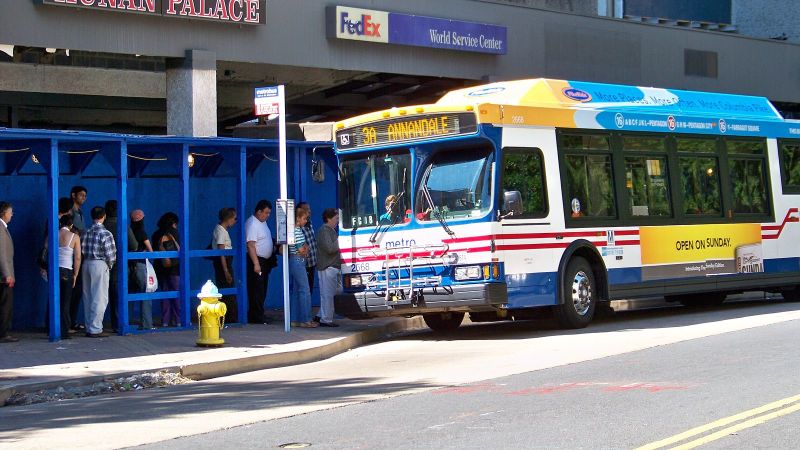The last few months have delivered bad news about U.S. transit: Ridership is declining in most cities; New York faces its first non-recession decline since the early 1990s; and there's an outright crisis in Washington. A new study suggests there is a bright spot in the long run -- but only if American cities invest in transit now.
The study by Rutgers' Michael Smart and Columbia's Nicholas Klein, "Remembrance of Cars and Buses Past," concerns habit formation. It implies that Millennials' habits of using transit, developed over the past decade or so, can persist throughout life -- but that on its own, this effect won't generate a significant transit revival without improving service and building transit-oriented development.
Habit formation has been studied before. See, for example, this paper by researchers at the University of Cardiff that found people who have just moved are more likely to use transit and less likely to drive than people who have lived in the same area for a long time. This remains true after controlling for income and other demographic variables. After moving to a place, people begin to develop a habit for driving, or for taking transit, and this persists later in life -- but not if they move again.
Smart and Klein look at a two-by-two matrix: Americans who live in high-transit census tracts versus low-transit tracts, and Americans who moved between a high-transit tract and a low-transit tract. People who moved from a high-transit area to a low-transit one ride transit at a higher rate and own fewer cars than people who have always lived in a low-transit tract. In the other direction, there is no persistence of car use: on the contrary, people who move from a low-transit tract to a high-transit tract have about the same transit usage as people who have always lived in a high-transit tract.
They then model the effects of past habits on transit use, and find that they are quite strong. People who get used to taking transit rather than driving are likely to keep doing so for decades. The formative age is the late 20s and early 30s: too old to be a young adult, but often too young to be entrenched in a place. In the middle class, this is roughly the age at which people begin to settle down and have children. For people age 40 to 60, the built environment they lived in when they were about 30 has twice the impact on their mode choice as the built environment they currently live in.
On the surface, it looks like a cause for optimism. Older Millennials, who got used to driving less than older cohorts in the late 2000s and early 2010s, will carry those habits with them as they get older. Moreover, habit formation shows evidence of being one-sided: People with experience with transit keep riding transit to some extent, people with experience with driving abandon the car when they move to a transit-rich neighborhood.
This may be related to research on the effect of fuel prices on transit use. Surging fuel prices last decade led to growth in transit ridership, but falling prices in the last few years did not lead to as big a decline. Experience with transit-rich neighborhoods creates a later habit of using transit more and driving less, as seems to be the case with the experience with having to use transit because fuel is too expensive.
While the habit formation effect is real, it is not, unfortunately, very large. Smart and Klein conclude:
Our work suggests that experiencing high-quality transit earlier in life can lead to a decrease of a couple of percentage points in car ownership rates and a meaningful increase in the likelihood (moving, roughly, from "very unlikely" to simply "unlikely" in the U.S. context) of using transit once or more a month.
Moving adults from being "very unlikely" to "unlikely" to use transit is a very low bar. So what is the relevance of this habit formation research for future planning?
One implication is that transit service should be easy to understand for recent movers. Rail services are usually pretty clear to new arrivals, but buses are harder. Here, the reforms that raise bus ridership via network redesign can also make service clearer for occasional users and newcomers. Bus grids are more legible than systems with extensive branching and recombination of routes. Routes that run consistent service all day are more legible than routes with special rush hour-only patterns. Some American cities are moving in this direction, but most still aren't.
But when it comes to the built environment, there is no special solution. If cities want transit use to move from the "very unlikely" category to "likely" and not just to "unlikely," they need to reorient the physical landscape through zoning for more compact development, lower parking requirements, road diets, dedicated bus lanes, bike lanes, and wide sidewalks. These ingredients all contribute to creating habits for walking, biking, and riding transit, but they also promote these modes without any relation to habit.
In areas where the quality of transit service is very poor, there is no substitute for the addition and expansion of service. In cities with only skeletal bus service and no rail (for example, Tampa, where systemwide bus ridership is 47,000 trips per day), creating a transit habit means adding more service, rather than reorganizing existing service. When buses are too slow to be useful, potentially controversial street interventions like bus lanes and signal priority for buses are necessary.
Smart and Klein's study gives some reason to be optimistic about future transit use by Millennials. But absent immediate investments, there is not going to be a transit revival in the United States. People will still suburbanize and get one car per adult if they can afford it, and the transit habit effect will remain small.





